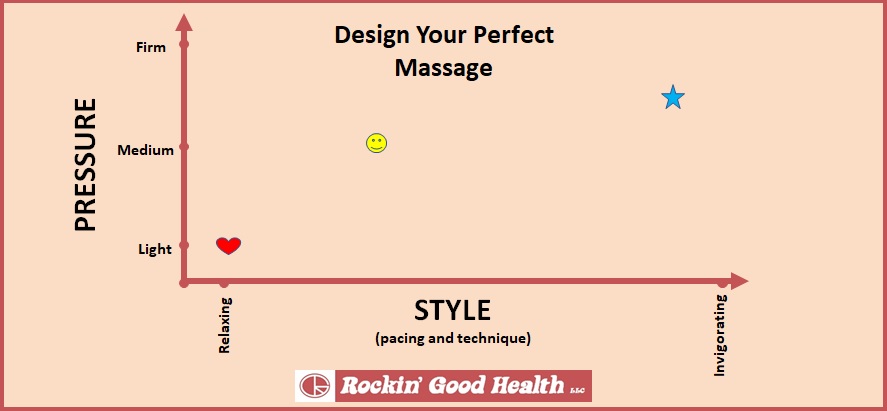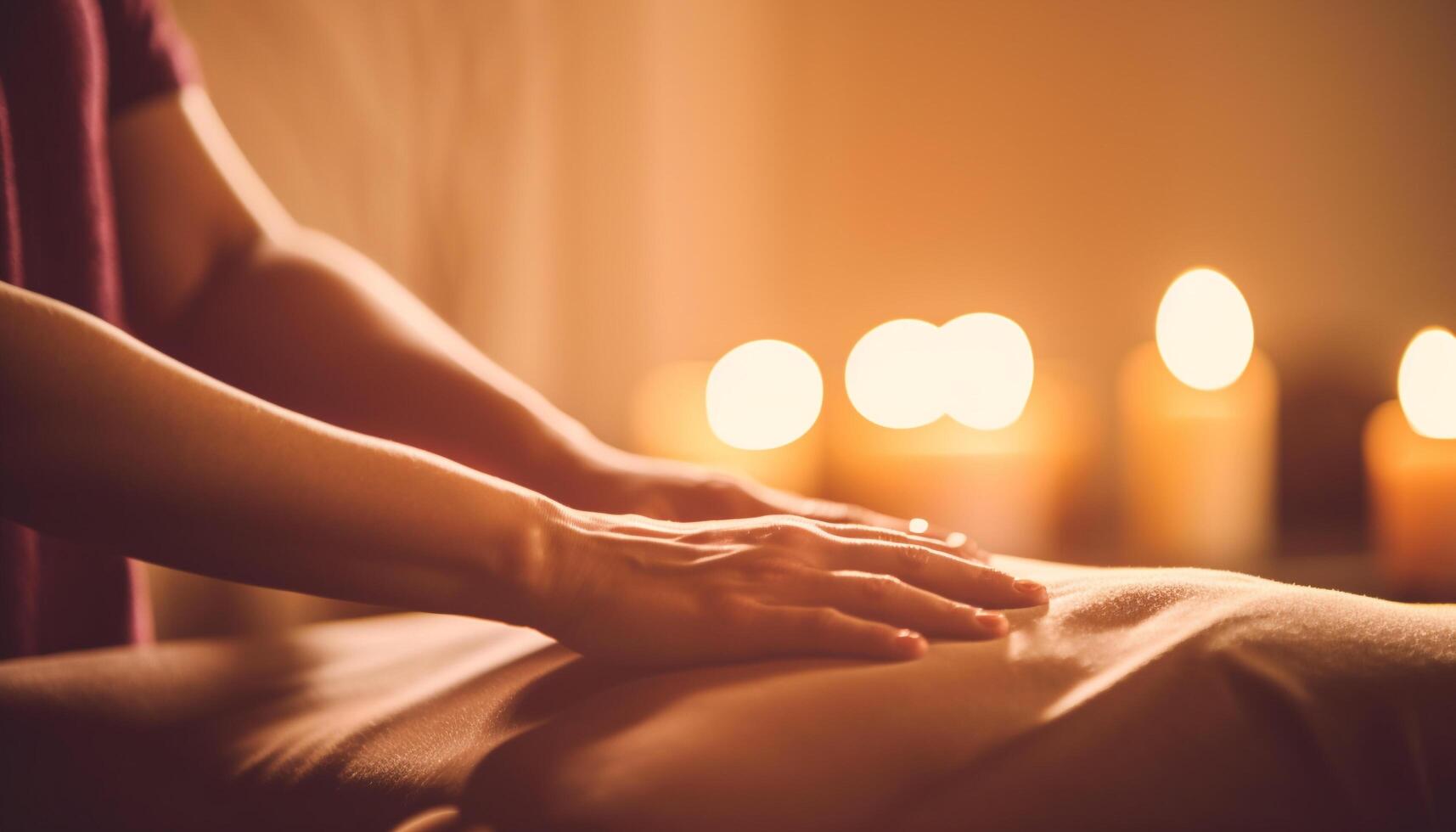You want the perfect massage, but you keep getting massages you don’t like. What’s going wrong, and what can you do about it?
Some people (including some massage therapists) think a restful massage has to be feather light, and a therapeutic or sports massage has to be “deep”. This couldn’t be farther from the truth! With this thinking, it’s no wonder people complain:
- I went to Big Box Massage and I said I wanted to relax, but I couldn’t even feel it!
- I told the person in the mall massage place that my shoulders were sore, and she really hurt me!
If you want to design the perfect massage, it’s best to keep TWO dimensions in mind, as shown in the figure above.
1: Pick Your Pressure

First, decide what kind of pressure you like: light, medium, or firm. Of course, you may like different pressure in different places. Whatever the case, tell your therapist how firm a pressure you like, and where.
Then, there’s a COMPLETELY DIFFERENT scale that is more about pacing and technique. Set pressure aside, and think about style.
2: Pick Your Style

Do you want to really chill out, maybe fall asleep, maybe see colors on the insides of your eyelids? Then you’re looking for a relaxing massage.
What if you want to get woken up and ready to compete (or maybe ready to party)? Now you’re talking about an invigorating massage.
In between, or somewhere else, is a therapeutic massage: mostly restful, with some focused work to relieve soreness, relax tightness, or stop a painful muscle spasm.
Here’s the point. A massage can be very relaxing, even with very firm pressure, if that’s what you enjoy. Or your massage can be very invigorating, even with a light touch. If you’re sore, a gentle massage, not a “deep tissue” massage, may be what you need. Don’t confuse your goal with the pressure needed to achieve it.
The Perfect Relaxation Massage: Get Your Ahhh On

For relaxation, I find the best massage has long, slow, repetitive, strokes. Pressure can be anywhere from feather light to very firm; the key is the pacing. I like to alter speed a little as I go, gently raising the client’s energy, then bringing it lower, still. On each new area of work (neck, arm, leg, etc.), I start at a snail’s pace, with very light pressure. I’ll increase both of these — but pressure only up to the client’s preference — and then slow the pace again, retaining the higher pressure. I finish each area with very slow, light, polishing strokes. I know I’ve got it right when I hear that long exhale… “ahhhh”.
For the ULTIMATE in relaxation, I recommend Lomi Lomi, but it’s not for everyone. What is Lomi Lomi massage? Read all about it!
The Perfect Invigorating Massage: Shake and Wake!

It’s Friday afternoon, and you’re ready for a big night out. Or, it’s the day before that 5K, and you want some real spring in your stride. An invigorating massage is just what you need!
Forget the long, slow strokes. Get ready for some stretching, jostling, shaking, tapping, and an upbeat pace. Believe it or not, the direction, speed, and technique you use to work a muscle can determine whether it stretches and softens, or firms and tightens. The last thing you want to do just before game day is to loosen (i.e. weaken) your muscles.
If I’m your therapist, you’re definitely NOT going to sleep on the table when I go full-on invigorating. Get ready to wake up!
The Perfect Therapeutic Massage: It's Touch, Not Pressure

People come to me in pain, and tell me, “Go as deep as you need to, don’t worry about hurting me.” I listen to that and wonder, what are they thinking? Sure, if you like a firm massage, that’s great. But I think these people want me to “hurt the pain” to make it go away, and I don’t think that works.
In fact, I’m a huge proponent of very light pressure for therapeutic purpose. A therapist with the right “touch” can simply wait, gently holding or lightly pressing, and a muscle in spasm will often let go.
It takes patience, and a therapist’s willingness to put their senses fully into the connection between their hands, and your muscles. I find that a tight muscle will often “mirror” my pressure; the harder I press, the tighter it gets. But when I back off, just slightly, I feel the muscle fibers relax, just slightly. I work with this, creating an interplay of repeated stimulus/relaxation cycles, where the level of relaxation is deeper with each successive release of pressure. When I get it right, there’s that “ahhh” again.
If you say “I’m hurting” and your therapist hears “dig in”, it’s time to find a new therapist. Hurting the pain is just plain wrong.
Are You Ready for Your Perfect Massage Now?
Now that you know how to design the perfect massage, it’s time to schedule an appointment! Be sure to tell your therapist, not just the pressure you like, but also the style.
And don’t be too disappointed if it takes time to find the therapist(s) that fit you best. Heck, I have a few who I call, depending on my goal for the massage. One knocks me out; I’m sleeping 5 minutes after she starts, and totally rested, for days, after she’s done. Another shakes me up; I’d never call her if I wanted to relax, but boy can she get me ready to rock! And another is great for that nagging pain in the neck.
And speaking of necks, if you’re in my neck of the woods, I invite you to make an appointment. Tell me your goals and your preferences, and I’ll do my best to accommodate.
Also, if you have a good or bad massage experience to share, please leave a comment, below. I’d love to hear what you think.
Sam Reichgott, LMT
PA License MSG009661
Rockin’ Good Health, LLC






